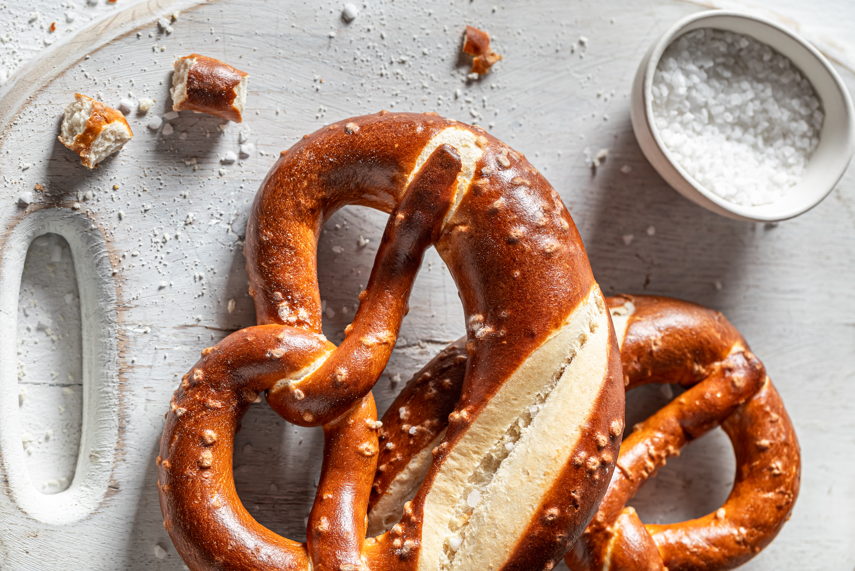Read More: Culinary History of Pretzel M Salt
The Pretzel’s Ancient Origins: A Tangled Knot of History
To understand the history of pretzel salt, we must first understand the history of the pretzel. The pretzel’s origins are shrouded in some mystery, with various legends and competing claims. However, most accounts trace its roots back to medieval Europe, likely sometime in the 7th century.
- Monastic Beginnings: A popular theory credits the invention of the pretzel to monks in Southern France or Northern Italy. The shape, resembling arms crossed in prayer, was supposedly used to reward children for learning their prayers. The three holes were said to represent the Holy Trinity.
- The “Pretiola”: The Latin word “pretiola,” meaning “little reward,” is often cited as a possible etymological ancestor of the word “pretzel.”
- Germanic Traditions: Pretzels became particularly popular in Germanic regions, where they evolved into various forms, both soft and hard. Bakers’ guilds in Germany adopted the pretzel as their emblem, reflecting its importance in their craft.
Early Pretzels and Salt: A Simpler Time
In these early days of pretzel making, the salt used would have been whatever was readily available. There was no specialized “pretzel salt” as we know it today. Likely, it would have been:
- Coarse Sea Salt: If the region had access to the coast, coarse sea salt, obtained through evaporation, would have been a common choice.
- Rock Salt: In inland areas, rock salt, mined from underground deposits, would have been used.
- Unrefined and Varied: These early salts would have been unrefined and likely contained various impurities, influencing their flavor and texture.
The primary purpose of the salt was preservation and basic seasoning. The concept of a salt specifically designed for texture and adherence was yet to emerge.
The Rise of Pretzel Baking as a Craft
As pretzel baking evolved from a monastic practice to a more widespread craft, particularly in Germany, bakers began to refine their techniques and ingredients. The development of lye (sodium hydroxide or potassium hydroxide) as a crucial ingredient in pretzel making was a significant turning point.
- The Lye Bath: Dipping the pretzel dough in a lye solution before baking is what gives pretzels their characteristic brown crust, chewy texture, and distinctive flavor. The lye reacts with the starches in the dough, creating a Maillard reaction during baking.
The introduction of the lye bath also had implications for the type of salt used. Fine salt would dissolve too quickly in the lye solution or melt away during baking, losing its textural impact. Coarser salts were better, but the ideal pretzel salt needed to possess specific properties.
The Emergence of Specialized Pretzel Salt
The precise origins of pretzel ‘M’ salt, as a distinct product, are difficult to pinpoint. It likely emerged gradually as a result of bakers’ experimentation and the desire to optimize the pretzel-eating experience. The key characteristics that define pretzel ‘M’ salt are:
- Large Crystal Size: Significantly larger than table salt or even most sea salts, providing a noticeable crunch.
- Flat, Plate-Like Shape: This shape maximizes surface area, allowing the salt to adhere better to the pretzel dough, even after the lye bath.
- Non-Melting Properties: The salt is designed to resist melting during baking, preserving its texture and visual appeal.
- Pure Sodium Chloride: Usually pure, without anti-caking ingredients.
The “M” in “pretzel ‘M’ salt” is often assumed to stand for “medium,” referring to the crystal size relative to other grades of salt. However, there’s no universally standardized grading system for pretzel salt, and the exact specifications can vary between manufacturers.
It is a non-melting salt.
Industrialization and the Standardization of Pretzel Salt
The industrialization of food production in the 19th and 20th centuries had a profound impact on pretzel making and, consequently, on pretzel salt. Mass-produced pretzels became increasingly common, and bakers sought consistent, reliable ingredients.
Salt companies began to produce specialized pretzel salts, engineered to meet the specific needs of pretzel bakers. These salts were designed for optimal adherence, texture, and flavor, ensuring a consistent product every time.
Pretzel ‘M’ Salt Today: A Culinary Staple
Today, pretzel ‘M’ salt is a readily available ingredient, sold in supermarkets, specialty food stores, and online retailers. It’s considered an essential component of authentic soft pretzels, and its use has expanded beyond its traditional application.
While it remains most closely associated with pretzels, pretzel ‘M’ salt is also used for:
- Bagels: Providing a similar textural contrast and salty flavor.
- Focaccia: Adding a crunchy topping to this Italian flatbread.
- Rimming Cocktail Glasses: Its large, flat crystals are visually appealing and adhere well to the rim.
- Other Culinary Applications: Some chefs and home cooks experiment with pretzel ‘M’ salt in other dishes where a bold, salty crunch is desired.
The Future of Pretzel ‘M’ Salt
The future of pretzel ‘M’ salt is likely tied to the enduring popularity of pretzels themselves. As long as people crave that perfect combination of soft, chewy interior and salty, crunchy exterior, pretzel ‘M’ salt will continue to play a vital role.
While innovation in food production is constant, the fundamental properties of pretzel ‘M’ salt – its large, flat, non-melting crystals – are unlikely to change significantly. It’s a testament to the power of simple ingredients, perfectly tailored to their specific culinary purpose. The history of pretzel ‘M’ salt is a reminder that even the smallest details, like the type of salt used, can have a profound impact on the final product and the overall sensory experience. It’s a story of culinary evolution, driven by the pursuit of perfection in a seemingly simple, yet deeply satisfying, food.


Share
Click on the icons below to share "Title of the item to share"